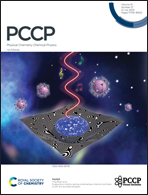Quantum anomalous Hall effect with a high and tunable Chern number in monolayer NdN2†
Abstract
Due to the presence of dissipationless edge states, the quantum anomalous Hall (QAH) insulator has garnered significant attention for both fundamental research and practical application. However, the majority of QAH insulators suffer from a low Chern number (C = 1), and the Chern number is basically unadjustable, which constrains their potential application in spintronic devices. Here, based on a tight-binding model and first-principles calculations, we propose that two-dimensional (2D) ferromagnetic monolayer NdN2 exhibits a high-Chern-number QAH effect with C = ±3, accompanied by a nontrivial band gap of 97.4 meV. More importantly, by manipulating the magnetization orientation in the xz plane, the Chern number of 2D NdN2 can be further tuned between C = ±3 and C = ±1. When the magnetization vector is confined to the xy plane, the monolayer NdN2 would exhibit either a Dirac half-semimetal or in-plane QAH phase. Moreover, the QAH effect with a higher Chern number C = 9 can be achieved by constructing a multilayer van der Waals heterostructure composed of monolayers NdN2 and BN with alternative stacking order. These findings provide a reliable platform for exploring the novel QAH effect and developing high-performance topological devices.



 Please wait while we load your content...
Please wait while we load your content...